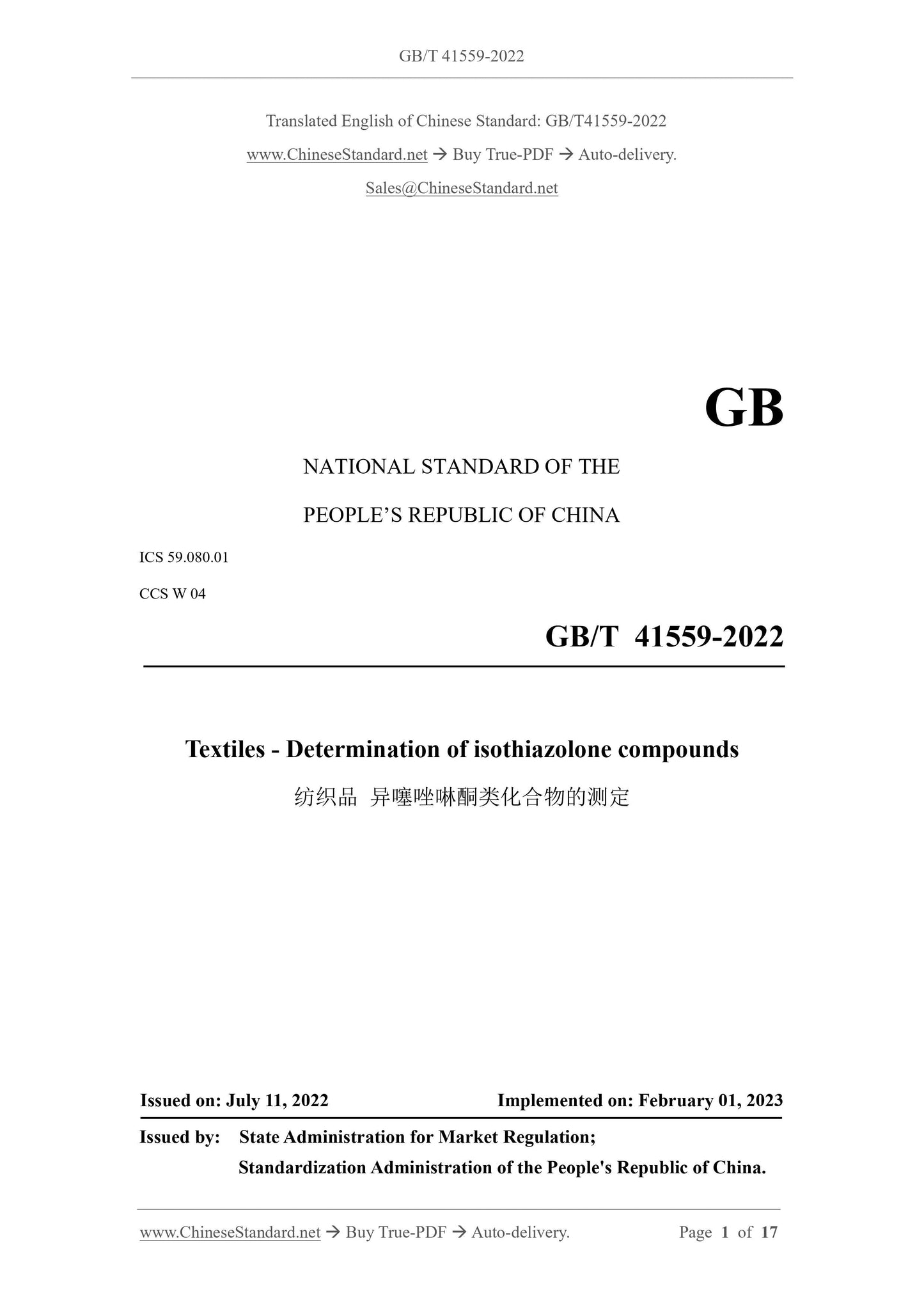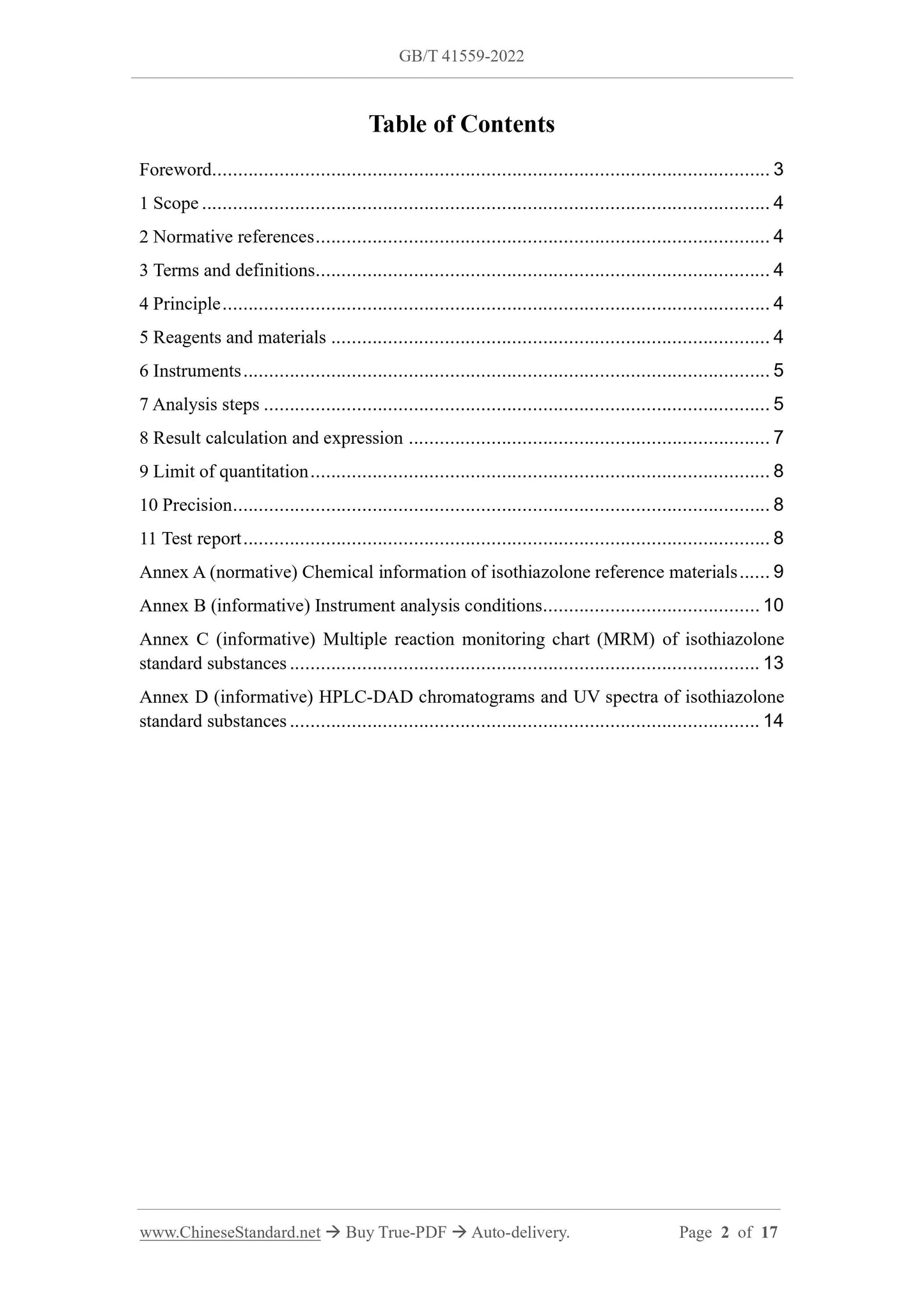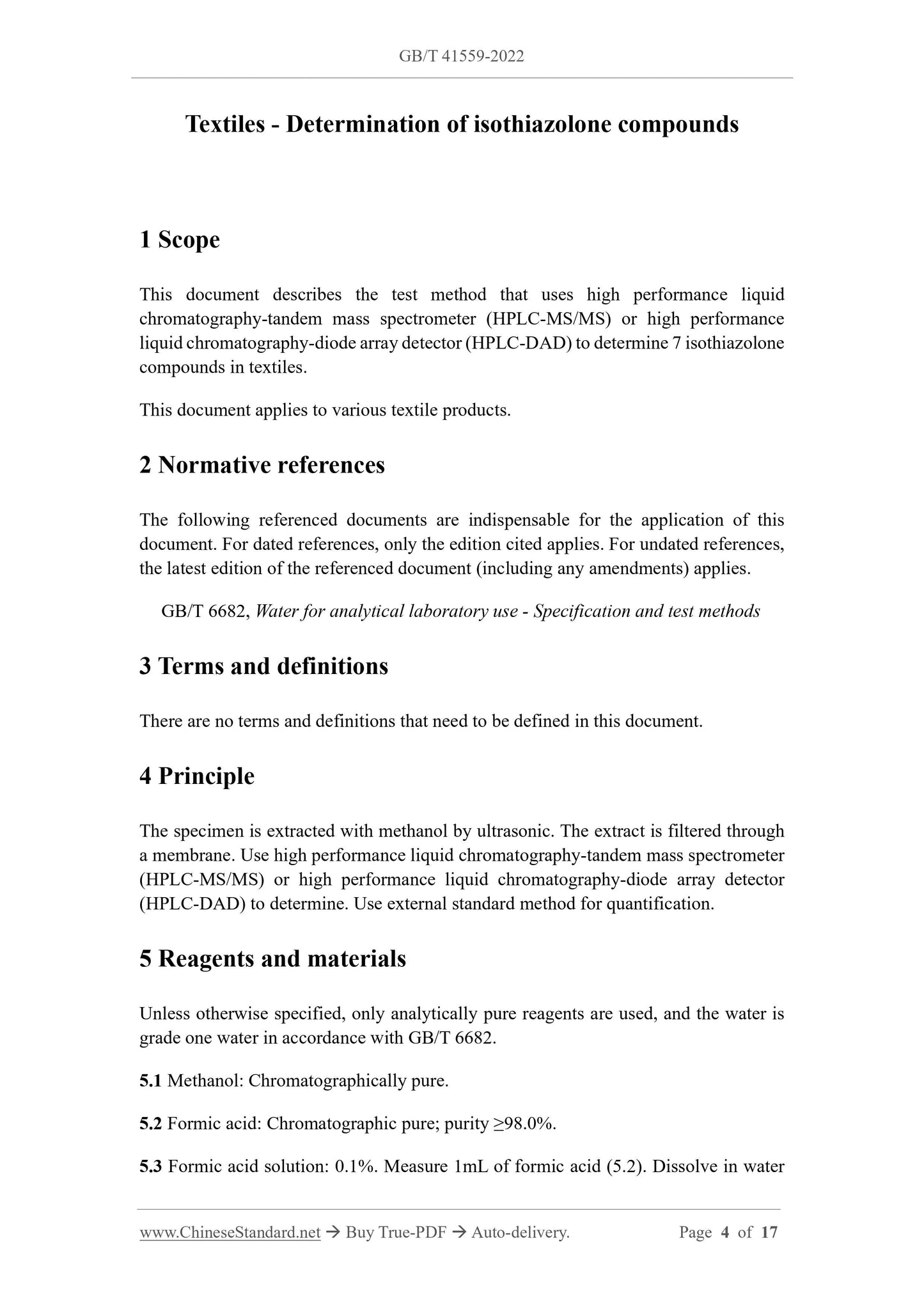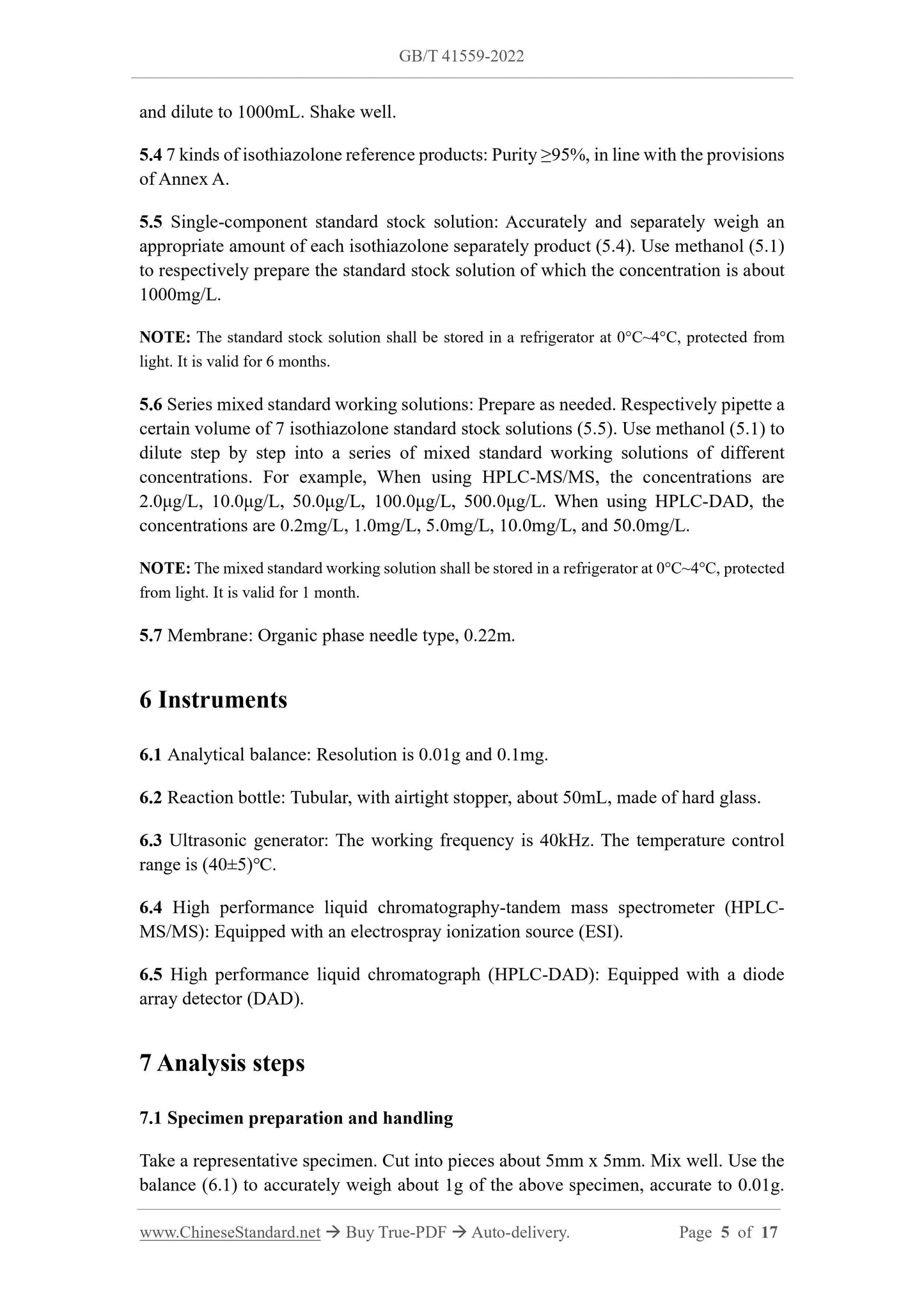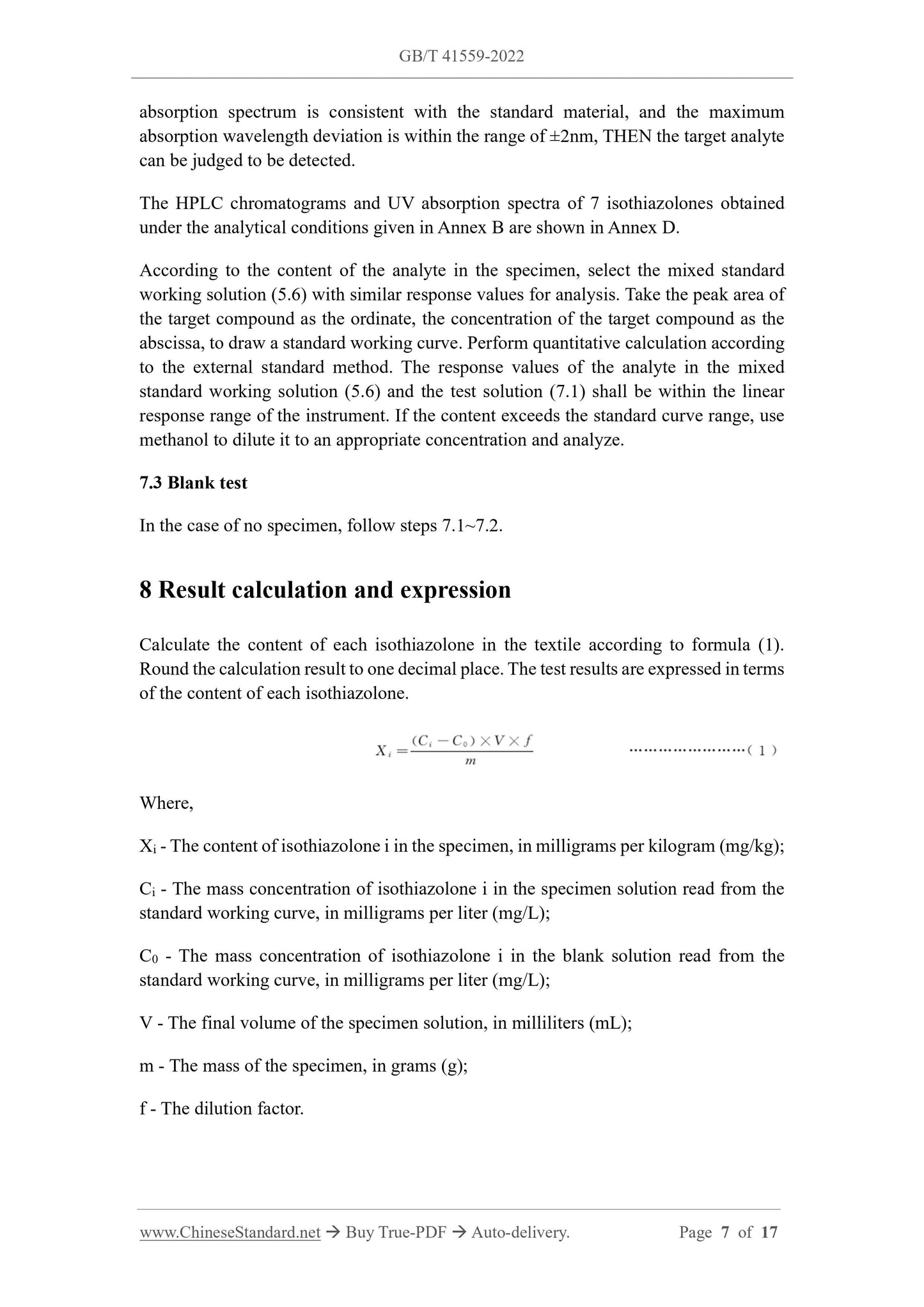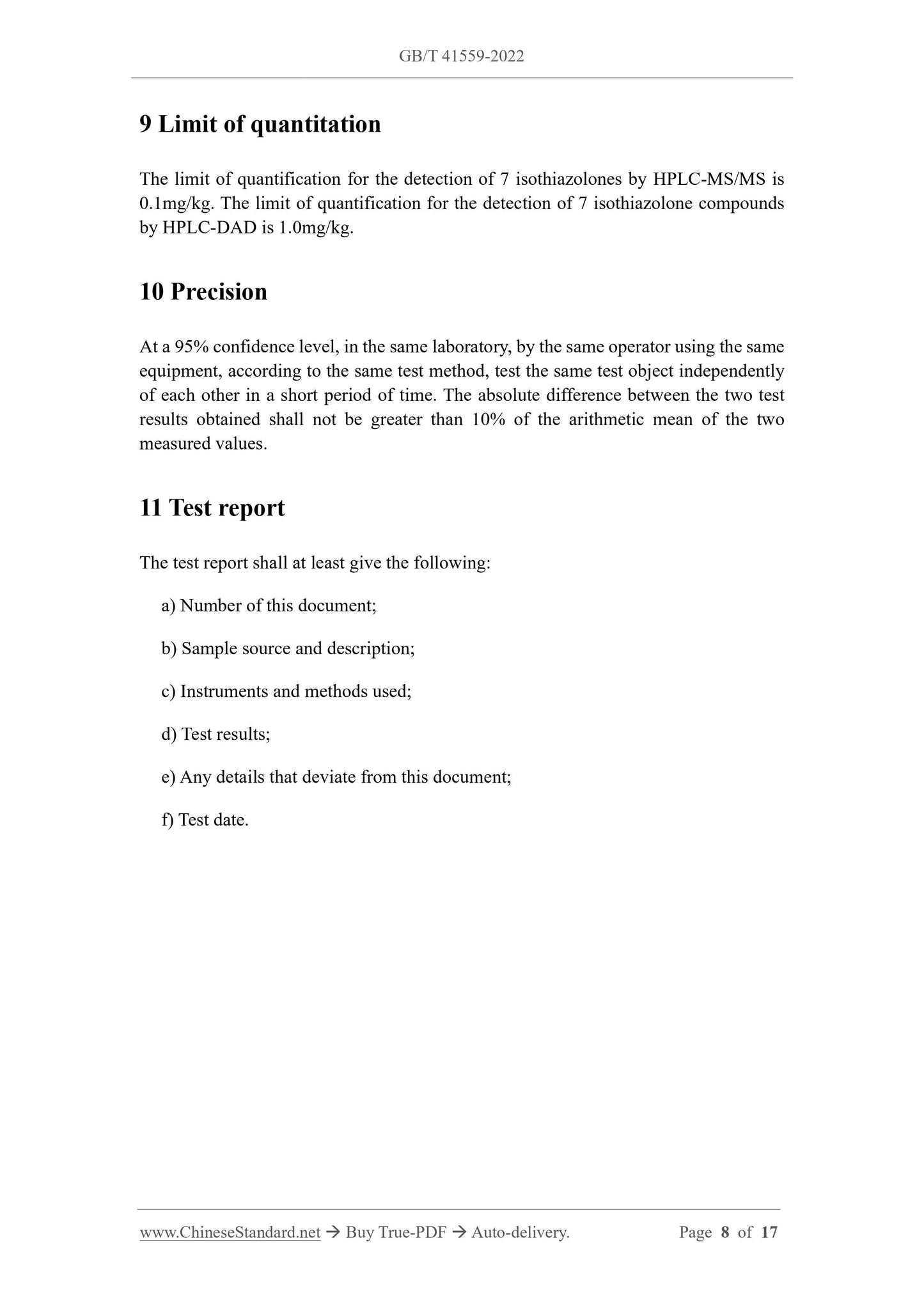1
/
of
6
www.ChineseStandard.us -- Field Test Asia Pte. Ltd.
GB/T 41559-2022 English PDF (GB/T41559-2022)
GB/T 41559-2022 English PDF (GB/T41559-2022)
Regular price
$260.00
Regular price
Sale price
$260.00
Unit price
/
per
Shipping calculated at checkout.
Couldn't load pickup availability
GB/T 41559-2022: Textiles - Determination of isothiazolone compounds
Delivery: 9 seconds. Download (& Email) true-PDF + Invoice.
Get Quotation: Click GB/T 41559-2022 (Self-service in 1-minute)
Historical versions (Master-website): GB/T 41559-2022
Preview True-PDF (Reload/Scroll-down if blank)
GB/T 41559-2022
NATIONAL STANDARD OF THE
PEOPLE’S REPUBLIC OF CHINA
ICS 59.080.01
CCS W 04
Textiles - Determination of isothiazolone compounds
ISSUED ON: JULY 11, 2022
IMPLEMENTED ON: FEBRUARY 01, 2023
Issued by: State Administration for Market Regulation;
Standardization Administration of the People's Republic of China.
Table of Contents
Foreword ... 3
1 Scope ... 4
2 Normative references ... 4
3 Terms and definitions... 4
4 Principle ... 4
5 Reagents and materials ... 4
6 Instruments ... 5
7 Analysis steps ... 5
8 Result calculation and expression ... 7
9 Limit of quantitation ... 8
10 Precision ... 8
11 Test report ... 8
Annex A (normative) Chemical information of isothiazolone reference materials ... 9
Annex B (informative) Instrument analysis conditions ... 10
Annex C (informative) Multiple reaction monitoring chart (MRM) of isothiazolone
standard substances ... 13
Annex D (informative) HPLC-DAD chromatograms and UV spectra of isothiazolone
standard substances ... 14
Textiles - Determination of isothiazolone compounds
1 Scope
This document describes the test method that uses high performance liquid
chromatography-tandem mass spectrometer (HPLC-MS/MS) or high performance
liquid chromatography-diode array detector (HPLC-DAD) to determine 7 isothiazolone
compounds in textiles.
This document applies to various textile products.
2 Normative references
The following referenced documents are indispensable for the application of this
document. For dated references, only the edition cited applies. For undated references,
the latest edition of the referenced document (including any amendments) applies.
GB/T 6682, Water for analytical laboratory use - Specification and test methods
3 Terms and definitions
There are no terms and definitions that need to be defined in this document.
4 Principle
The specimen is extracted with methanol by ultrasonic. The extract is filtered through
a membrane. Use high performance liquid chromatography-tandem mass spectrometer
(HPLC-MS/MS) or high performance liquid chromatography-diode array detector
(HPLC-DAD) to determine. Use external standard method for quantification.
5 Reagents and materials
Unless otherwise specified, only analytically pure reagents are used, and the water is
grade one water in accordance with GB/T 6682.
5.1 Methanol: Chromatographically pure.
5.2 Formic acid: Chromatographic pure; purity ≥98.0%.
5.3 Formic acid solution: 0.1%. Measure 1mL of formic acid (5.2). Dissolve in water
and dilute to 1000mL. Shake well.
5.4 7 kinds of isothiazolone reference products: Purity ≥95%, in line with the provisions
of Annex A.
5.5 Single-component standard stock solution: Accurately and separately weigh an
appropriate amount of each isothiazolone separately product (5.4). Use methanol (5.1)
to respectively prepare the standard stock solution of which the concentration is about
1000mg/L.
NOTE: The standard stock solution shall be stored in a refrigerator at 0°C~4°C, protected from
light. It is valid for 6 months.
5.6 Series mixed standard working solutions: Prepare as needed. Respectively pipette a
certain volume of 7 isothiazolone standard stock solutions (5.5). Use methanol (5.1) to
dilute step by step into a series of mixed standard working solutions of different
concentrations. For example, When using HPLC-MS/MS, the concentrations are
2.0μg/L, 10.0μg/L, 50.0μg/L, 100.0μg/L, 500.0μg/L. When using HPLC-DAD, the
concentrations are 0.2mg/L, 1.0mg/L, 5.0mg/L, 10.0mg/L, and 50.0mg/L.
NOTE: The mixed standard working solution shall be stored in a refrigerator at 0°C~4°C, protected
from light. It is valid for 1 month.
5.7 Membrane: Organic phase needle type, 0.22m.
6 Instruments
6.1 Analytical balance: Resolution is 0.01g and 0.1mg.
6.2 Reaction bottle: Tubular, with airtight stopper, about 50mL, made of hard glass.
6.3 Ultrasonic generator: The working frequency is 40kHz. The temperature control
range is (40±5)℃.
6.4 High performance liquid chromatography-tandem mass spectrometer (HPLC-
MS/MS): Equipped with an electrospray ionization source (ESI).
6.5 High performance liquid chromatograph (HPLC-DAD): Equipped with a diode
array detector (DAD).
7 Analysis steps
7.1 Specimen preparation and handling
Take a representative specimen. Cut into pieces about 5mm x 5mm. Mix well. Use the
balance (6.1) to accurately weigh about 1g of the above specimen, accurate to 0.01g.
absorption spectrum is consistent with the standard material, and the maximum
absorption wavelength deviation is within the range of ±2nm, THEN the target analyte
can be judged to be detected.
The HPLC chromatograms and UV absorption spectra of 7 isothiazolones obtained
under the analytical conditions given in Annex B are shown in Annex D.
According to the content of the analyte in the specimen, select the mixed standard
working solution (5.6) with similar response values for analysis. Take the peak area of
the target compound as the ordinate, the concentration of the target compound as the
abscissa, to draw a standard working curve. Perform quantitative calculation according
to the external standard method. The response values of the analyte in the mixed
standard working solution (5.6) and the test solution (7.1) shall be within the linear
response range of the instrument. If the content exceeds the standard curve range, use
methanol to dilute it to an appropriate concentration and analyze.
7.3 Blank test
In the case of no specimen, follow steps 7.1~7.2.
8 Result calculation and expression
Calculate the content of each isothiazolone in the textile according to formula (1).
Round the calculation result to one decimal place. The test results are expressed in terms
of the content of each isothiazolone.
Where,
Xi - The content of isothiazolone i in the specimen, in milligrams per kilogram (mg/kg);
Ci - The mass concentration of isothiazolone i in the specimen solution read from the
standard working curve, in milligrams per liter (mg/L);
C0 - The mass concentration of isothiazolone i in the blank solution read from the
standard working curve, in milligrams per liter (mg/L);
V - The final volume of the specimen solution, in milliliters (mL);
m - The mass of the specimen, in grams (g);
f - The dilution factor.
9 Limit of quantitation
The limit of quantification for the detection of 7 isothiazolones by HPLC-MS/MS is
0.1mg/kg. The limit of quantification for the detection of 7 isothiazolone compounds
by HPLC-DAD is 1.0mg/kg.
10 Precision
At a 95% confidence level, in the same laboratory, by the same operator using the same
equipment, according to the same test method, test the same test object independently
of each other in a short period of time. The absolute difference between the two test
results obtained shall not be greater than 10% of the arithmetic mean of the two
measured values.
11 Test report
The test report shall at least give the following:
a) Number of this document;
b) Sample source and description;
c) Instruments and methods used;
d) Test results;
e) Any details that deviate from this document;
f) Test date.
GB/T 41559-2022
NATIONAL STANDARD OF THE
PEOPLE’S REPUBLIC OF CHINA
ICS 59.080.01
CCS W 04
Textiles - Determination of isothiazolone compounds
ISSUED ON: JULY 11, 2022
IMPLEMENTED ON: FEBRUARY 01, 2023
Issued by: State Administration for Market Regulation;
Standardization Administration of the People's Republic of China.
Table of Contents
Foreword ... 3
1 Scope ... 4
2 Normative references ... 4
3 Terms and definitions... 4
4 Principle ... 4
5 Reagents and materials ... 4
6 Instruments ... 5
7 Analysis steps ... 5
8 Result calculation and expression ... 7
9 Limit of quantitation ... 8
10 Precision ... 8
11 Test report ... 8
Annex A (normative) Chemical information of isothiazolone reference materials ... 9
Annex B (informative) Instrument analysis conditions ... 10
Annex C (informative) Multiple reaction monitoring chart (MRM) of isothiazolone
standard substances ... 13
Annex D (informative) HPLC-DAD chromatograms and UV spectra of isothiazolone
standard substances ... 14
Textiles - Determination of isothiazolone compounds
1 Scope
This document describes the test method that uses high performance liquid
chromatography-tandem mass spectrometer (HPLC-MS/MS) or high performance
liquid chromatography-diode array detector (HPLC-DAD) to determine 7 isothiazolone
compounds in textiles.
This document applies to various textile products.
2 Normative references
The following referenced documents are indispensable for the application of this
document. For dated references, only the edition cited applies. For undated references,
the latest edition of the referenced document (including any amendments) applies.
GB/T 6682, Water for analytical laboratory use - Specification and test methods
3 Terms and definitions
There are no terms and definitions that need to be defined in this document.
4 Principle
The specimen is extracted with methanol by ultrasonic. The extract is filtered through
a membrane. Use high performance liquid chromatography-tandem mass spectrometer
(HPLC-MS/MS) or high performance liquid chromatography-diode array detector
(HPLC-DAD) to determine. Use external standard method for quantification.
5 Reagents and materials
Unless otherwise specified, only analytically pure reagents are used, and the water is
grade one water in accordance with GB/T 6682.
5.1 Methanol: Chromatographically pure.
5.2 Formic acid: Chromatographic pure; purity ≥98.0%.
5.3 Formic acid solution: 0.1%. Measure 1mL of formic acid (5.2). Dissolve in water
and dilute to 1000mL. Shake well.
5.4 7 kinds of isothiazolone reference products: Purity ≥95%, in line with the provisions
of Annex A.
5.5 Single-component standard stock solution: Accurately and separately weigh an
appropriate amount of each isothiazolone separately product (5.4). Use methanol (5.1)
to respectively prepare the standard stock solution of which the concentration is about
1000mg/L.
NOTE: The standard stock solution shall be stored in a refrigerator at 0°C~4°C, protected from
light. It is valid for 6 months.
5.6 Series mixed standard working solutions: Prepare as needed. Respectively pipette a
certain volume of 7 isothiazolone standard stock solutions (5.5). Use methanol (5.1) to
dilute step by step into a series of mixed standard working solutions of different
concentrations. For example, When using HPLC-MS/MS, the concentrations are
2.0μg/L, 10.0μg/L, 50.0μg/L, 100.0μg/L, 500.0μg/L. When using HPLC-DAD, the
concentrations are 0.2mg/L, 1.0mg/L, 5.0mg/L, 10.0mg/L, and 50.0mg/L.
NOTE: The mixed standard working solution shall be stored in a refrigerator at 0°C~4°C, protected
from light. It is valid for 1 month.
5.7 Membrane: Organic phase needle type, 0.22m.
6 Instruments
6.1 Analytical balance: Resolution is 0.01g and 0.1mg.
6.2 Reaction bottle: Tubular, with airtight stopper, about 50mL, made of hard glass.
6.3 Ultrasonic generator: The working frequency is 40kHz. The temperature control
range is (40±5)℃.
6.4 High performance liquid chromatography-tandem mass spectrometer (HPLC-
MS/MS): Equipped with an electrospray ionization source (ESI).
6.5 High performance liquid chromatograph (HPLC-DAD): Equipped with a diode
array detector (DAD).
7 Analysis steps
7.1 Specimen preparation and handling
Take a representative specimen. Cut into pieces about 5mm x 5mm. Mix well. Use the
balance (6.1) to accurately weigh about 1g of the above specimen, accurate to 0.01g.
absorption spectrum is consistent with the standard material, and the maximum
absorption wavelength deviation is within the range of ±2nm, THEN the target analyte
can be judged to be detected.
The HPLC chromatograms and UV absorption spectra of 7 isothiazolones obtained
under the analytical conditions given in Annex B are shown in Annex D.
According to the content of the analyte in the specimen, select the mixed standard
working solution (5.6) with similar response values for analysis. Take the peak area of
the target compound as the ordinate, the concentration of the target compound as the
abscissa, to draw a standard working curve. Perform quantitative calculation according
to the external standard method. The response values of the analyte in the mixed
standard working solution (5.6) and the test solution (7.1) shall be within the linear
response range of the instrument. If the content exceeds the standard curve range, use
methanol to dilute it to an appropriate concentration and analyze.
7.3 Blank test
In the case of no specimen, follow steps 7.1~7.2.
8 Result calculation and expression
Calculate the content of each isothiazolone in the textile according to formula (1).
Round the calculation result to one decimal place. The test results are expressed in terms
of the content of each isothiazolone.
Where,
Xi - The content of isothiazolone i in the specimen, in milligrams per kilogram (mg/kg);
Ci - The mass concentration of isothiazolone i in the specimen solution read from the
standard working curve, in milligrams per liter (mg/L);
C0 - The mass concentration of isothiazolone i in the blank solution read from the
standard working curve, in milligrams per liter (mg/L);
V - The final volume of the specimen solution, in milliliters (mL);
m - The mass of the specimen, in grams (g);
f - The dilution factor.
9 Limit of quantitation
The limit of quantification for the detection of 7 isothiazolones by HPLC-MS/MS is
0.1mg/kg. The limit of quantification for the detection of 7 isothiazolone compounds
by HPLC-DAD is 1.0mg/kg.
10 Precision
At a 95% confidence level, in the same laboratory, by the same operator using the same
equipment, according to the same test method, test the same test object independently
of each other in a short period of time. The absolute differe...
Delivery: 9 seconds. Download (& Email) true-PDF + Invoice.
Get Quotation: Click GB/T 41559-2022 (Self-service in 1-minute)
Historical versions (Master-website): GB/T 41559-2022
Preview True-PDF (Reload/Scroll-down if blank)
GB/T 41559-2022
NATIONAL STANDARD OF THE
PEOPLE’S REPUBLIC OF CHINA
ICS 59.080.01
CCS W 04
Textiles - Determination of isothiazolone compounds
ISSUED ON: JULY 11, 2022
IMPLEMENTED ON: FEBRUARY 01, 2023
Issued by: State Administration for Market Regulation;
Standardization Administration of the People's Republic of China.
Table of Contents
Foreword ... 3
1 Scope ... 4
2 Normative references ... 4
3 Terms and definitions... 4
4 Principle ... 4
5 Reagents and materials ... 4
6 Instruments ... 5
7 Analysis steps ... 5
8 Result calculation and expression ... 7
9 Limit of quantitation ... 8
10 Precision ... 8
11 Test report ... 8
Annex A (normative) Chemical information of isothiazolone reference materials ... 9
Annex B (informative) Instrument analysis conditions ... 10
Annex C (informative) Multiple reaction monitoring chart (MRM) of isothiazolone
standard substances ... 13
Annex D (informative) HPLC-DAD chromatograms and UV spectra of isothiazolone
standard substances ... 14
Textiles - Determination of isothiazolone compounds
1 Scope
This document describes the test method that uses high performance liquid
chromatography-tandem mass spectrometer (HPLC-MS/MS) or high performance
liquid chromatography-diode array detector (HPLC-DAD) to determine 7 isothiazolone
compounds in textiles.
This document applies to various textile products.
2 Normative references
The following referenced documents are indispensable for the application of this
document. For dated references, only the edition cited applies. For undated references,
the latest edition of the referenced document (including any amendments) applies.
GB/T 6682, Water for analytical laboratory use - Specification and test methods
3 Terms and definitions
There are no terms and definitions that need to be defined in this document.
4 Principle
The specimen is extracted with methanol by ultrasonic. The extract is filtered through
a membrane. Use high performance liquid chromatography-tandem mass spectrometer
(HPLC-MS/MS) or high performance liquid chromatography-diode array detector
(HPLC-DAD) to determine. Use external standard method for quantification.
5 Reagents and materials
Unless otherwise specified, only analytically pure reagents are used, and the water is
grade one water in accordance with GB/T 6682.
5.1 Methanol: Chromatographically pure.
5.2 Formic acid: Chromatographic pure; purity ≥98.0%.
5.3 Formic acid solution: 0.1%. Measure 1mL of formic acid (5.2). Dissolve in water
and dilute to 1000mL. Shake well.
5.4 7 kinds of isothiazolone reference products: Purity ≥95%, in line with the provisions
of Annex A.
5.5 Single-component standard stock solution: Accurately and separately weigh an
appropriate amount of each isothiazolone separately product (5.4). Use methanol (5.1)
to respectively prepare the standard stock solution of which the concentration is about
1000mg/L.
NOTE: The standard stock solution shall be stored in a refrigerator at 0°C~4°C, protected from
light. It is valid for 6 months.
5.6 Series mixed standard working solutions: Prepare as needed. Respectively pipette a
certain volume of 7 isothiazolone standard stock solutions (5.5). Use methanol (5.1) to
dilute step by step into a series of mixed standard working solutions of different
concentrations. For example, When using HPLC-MS/MS, the concentrations are
2.0μg/L, 10.0μg/L, 50.0μg/L, 100.0μg/L, 500.0μg/L. When using HPLC-DAD, the
concentrations are 0.2mg/L, 1.0mg/L, 5.0mg/L, 10.0mg/L, and 50.0mg/L.
NOTE: The mixed standard working solution shall be stored in a refrigerator at 0°C~4°C, protected
from light. It is valid for 1 month.
5.7 Membrane: Organic phase needle type, 0.22m.
6 Instruments
6.1 Analytical balance: Resolution is 0.01g and 0.1mg.
6.2 Reaction bottle: Tubular, with airtight stopper, about 50mL, made of hard glass.
6.3 Ultrasonic generator: The working frequency is 40kHz. The temperature control
range is (40±5)℃.
6.4 High performance liquid chromatography-tandem mass spectrometer (HPLC-
MS/MS): Equipped with an electrospray ionization source (ESI).
6.5 High performance liquid chromatograph (HPLC-DAD): Equipped with a diode
array detector (DAD).
7 Analysis steps
7.1 Specimen preparation and handling
Take a representative specimen. Cut into pieces about 5mm x 5mm. Mix well. Use the
balance (6.1) to accurately weigh about 1g of the above specimen, accurate to 0.01g.
absorption spectrum is consistent with the standard material, and the maximum
absorption wavelength deviation is within the range of ±2nm, THEN the target analyte
can be judged to be detected.
The HPLC chromatograms and UV absorption spectra of 7 isothiazolones obtained
under the analytical conditions given in Annex B are shown in Annex D.
According to the content of the analyte in the specimen, select the mixed standard
working solution (5.6) with similar response values for analysis. Take the peak area of
the target compound as the ordinate, the concentration of the target compound as the
abscissa, to draw a standard working curve. Perform quantitative calculation according
to the external standard method. The response values of the analyte in the mixed
standard working solution (5.6) and the test solution (7.1) shall be within the linear
response range of the instrument. If the content exceeds the standard curve range, use
methanol to dilute it to an appropriate concentration and analyze.
7.3 Blank test
In the case of no specimen, follow steps 7.1~7.2.
8 Result calculation and expression
Calculate the content of each isothiazolone in the textile according to formula (1).
Round the calculation result to one decimal place. The test results are expressed in terms
of the content of each isothiazolone.
Where,
Xi - The content of isothiazolone i in the specimen, in milligrams per kilogram (mg/kg);
Ci - The mass concentration of isothiazolone i in the specimen solution read from the
standard working curve, in milligrams per liter (mg/L);
C0 - The mass concentration of isothiazolone i in the blank solution read from the
standard working curve, in milligrams per liter (mg/L);
V - The final volume of the specimen solution, in milliliters (mL);
m - The mass of the specimen, in grams (g);
f - The dilution factor.
9 Limit of quantitation
The limit of quantification for the detection of 7 isothiazolones by HPLC-MS/MS is
0.1mg/kg. The limit of quantification for the detection of 7 isothiazolone compounds
by HPLC-DAD is 1.0mg/kg.
10 Precision
At a 95% confidence level, in the same laboratory, by the same operator using the same
equipment, according to the same test method, test the same test object independently
of each other in a short period of time. The absolute difference between the two test
results obtained shall not be greater than 10% of the arithmetic mean of the two
measured values.
11 Test report
The test report shall at least give the following:
a) Number of this document;
b) Sample source and description;
c) Instruments and methods used;
d) Test results;
e) Any details that deviate from this document;
f) Test date.
GB/T 41559-2022
NATIONAL STANDARD OF THE
PEOPLE’S REPUBLIC OF CHINA
ICS 59.080.01
CCS W 04
Textiles - Determination of isothiazolone compounds
ISSUED ON: JULY 11, 2022
IMPLEMENTED ON: FEBRUARY 01, 2023
Issued by: State Administration for Market Regulation;
Standardization Administration of the People's Republic of China.
Table of Contents
Foreword ... 3
1 Scope ... 4
2 Normative references ... 4
3 Terms and definitions... 4
4 Principle ... 4
5 Reagents and materials ... 4
6 Instruments ... 5
7 Analysis steps ... 5
8 Result calculation and expression ... 7
9 Limit of quantitation ... 8
10 Precision ... 8
11 Test report ... 8
Annex A (normative) Chemical information of isothiazolone reference materials ... 9
Annex B (informative) Instrument analysis conditions ... 10
Annex C (informative) Multiple reaction monitoring chart (MRM) of isothiazolone
standard substances ... 13
Annex D (informative) HPLC-DAD chromatograms and UV spectra of isothiazolone
standard substances ... 14
Textiles - Determination of isothiazolone compounds
1 Scope
This document describes the test method that uses high performance liquid
chromatography-tandem mass spectrometer (HPLC-MS/MS) or high performance
liquid chromatography-diode array detector (HPLC-DAD) to determine 7 isothiazolone
compounds in textiles.
This document applies to various textile products.
2 Normative references
The following referenced documents are indispensable for the application of this
document. For dated references, only the edition cited applies. For undated references,
the latest edition of the referenced document (including any amendments) applies.
GB/T 6682, Water for analytical laboratory use - Specification and test methods
3 Terms and definitions
There are no terms and definitions that need to be defined in this document.
4 Principle
The specimen is extracted with methanol by ultrasonic. The extract is filtered through
a membrane. Use high performance liquid chromatography-tandem mass spectrometer
(HPLC-MS/MS) or high performance liquid chromatography-diode array detector
(HPLC-DAD) to determine. Use external standard method for quantification.
5 Reagents and materials
Unless otherwise specified, only analytically pure reagents are used, and the water is
grade one water in accordance with GB/T 6682.
5.1 Methanol: Chromatographically pure.
5.2 Formic acid: Chromatographic pure; purity ≥98.0%.
5.3 Formic acid solution: 0.1%. Measure 1mL of formic acid (5.2). Dissolve in water
and dilute to 1000mL. Shake well.
5.4 7 kinds of isothiazolone reference products: Purity ≥95%, in line with the provisions
of Annex A.
5.5 Single-component standard stock solution: Accurately and separately weigh an
appropriate amount of each isothiazolone separately product (5.4). Use methanol (5.1)
to respectively prepare the standard stock solution of which the concentration is about
1000mg/L.
NOTE: The standard stock solution shall be stored in a refrigerator at 0°C~4°C, protected from
light. It is valid for 6 months.
5.6 Series mixed standard working solutions: Prepare as needed. Respectively pipette a
certain volume of 7 isothiazolone standard stock solutions (5.5). Use methanol (5.1) to
dilute step by step into a series of mixed standard working solutions of different
concentrations. For example, When using HPLC-MS/MS, the concentrations are
2.0μg/L, 10.0μg/L, 50.0μg/L, 100.0μg/L, 500.0μg/L. When using HPLC-DAD, the
concentrations are 0.2mg/L, 1.0mg/L, 5.0mg/L, 10.0mg/L, and 50.0mg/L.
NOTE: The mixed standard working solution shall be stored in a refrigerator at 0°C~4°C, protected
from light. It is valid for 1 month.
5.7 Membrane: Organic phase needle type, 0.22m.
6 Instruments
6.1 Analytical balance: Resolution is 0.01g and 0.1mg.
6.2 Reaction bottle: Tubular, with airtight stopper, about 50mL, made of hard glass.
6.3 Ultrasonic generator: The working frequency is 40kHz. The temperature control
range is (40±5)℃.
6.4 High performance liquid chromatography-tandem mass spectrometer (HPLC-
MS/MS): Equipped with an electrospray ionization source (ESI).
6.5 High performance liquid chromatograph (HPLC-DAD): Equipped with a diode
array detector (DAD).
7 Analysis steps
7.1 Specimen preparation and handling
Take a representative specimen. Cut into pieces about 5mm x 5mm. Mix well. Use the
balance (6.1) to accurately weigh about 1g of the above specimen, accurate to 0.01g.
absorption spectrum is consistent with the standard material, and the maximum
absorption wavelength deviation is within the range of ±2nm, THEN the target analyte
can be judged to be detected.
The HPLC chromatograms and UV absorption spectra of 7 isothiazolones obtained
under the analytical conditions given in Annex B are shown in Annex D.
According to the content of the analyte in the specimen, select the mixed standard
working solution (5.6) with similar response values for analysis. Take the peak area of
the target compound as the ordinate, the concentration of the target compound as the
abscissa, to draw a standard working curve. Perform quantitative calculation according
to the external standard method. The response values of the analyte in the mixed
standard working solution (5.6) and the test solution (7.1) shall be within the linear
response range of the instrument. If the content exceeds the standard curve range, use
methanol to dilute it to an appropriate concentration and analyze.
7.3 Blank test
In the case of no specimen, follow steps 7.1~7.2.
8 Result calculation and expression
Calculate the content of each isothiazolone in the textile according to formula (1).
Round the calculation result to one decimal place. The test results are expressed in terms
of the content of each isothiazolone.
Where,
Xi - The content of isothiazolone i in the specimen, in milligrams per kilogram (mg/kg);
Ci - The mass concentration of isothiazolone i in the specimen solution read from the
standard working curve, in milligrams per liter (mg/L);
C0 - The mass concentration of isothiazolone i in the blank solution read from the
standard working curve, in milligrams per liter (mg/L);
V - The final volume of the specimen solution, in milliliters (mL);
m - The mass of the specimen, in grams (g);
f - The dilution factor.
9 Limit of quantitation
The limit of quantification for the detection of 7 isothiazolones by HPLC-MS/MS is
0.1mg/kg. The limit of quantification for the detection of 7 isothiazolone compounds
by HPLC-DAD is 1.0mg/kg.
10 Precision
At a 95% confidence level, in the same laboratory, by the same operator using the same
equipment, according to the same test method, test the same test object independently
of each other in a short period of time. The absolute differe...
Share
